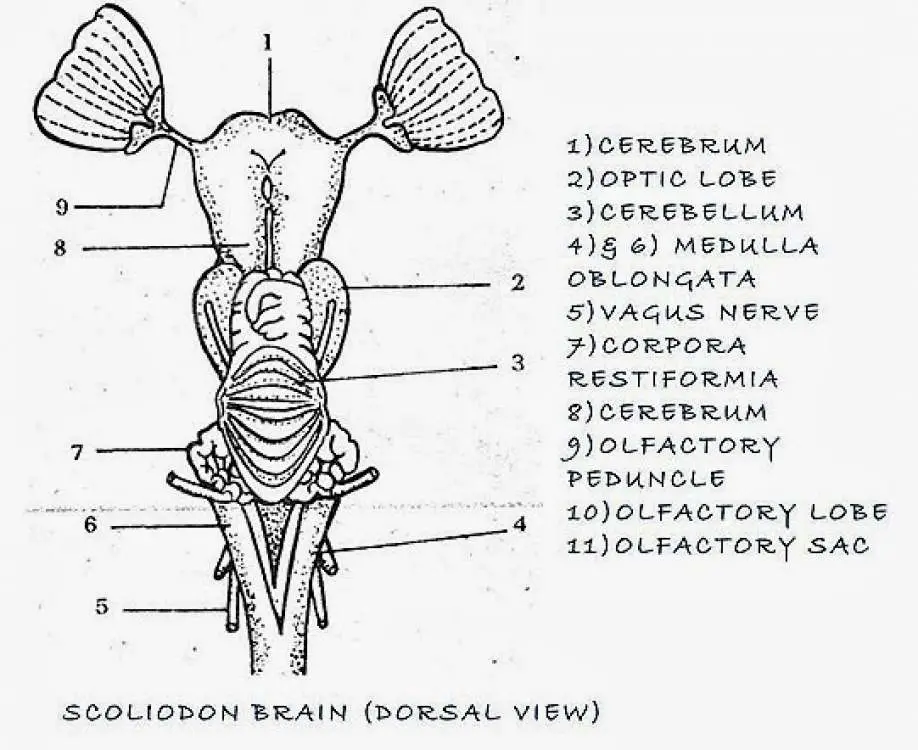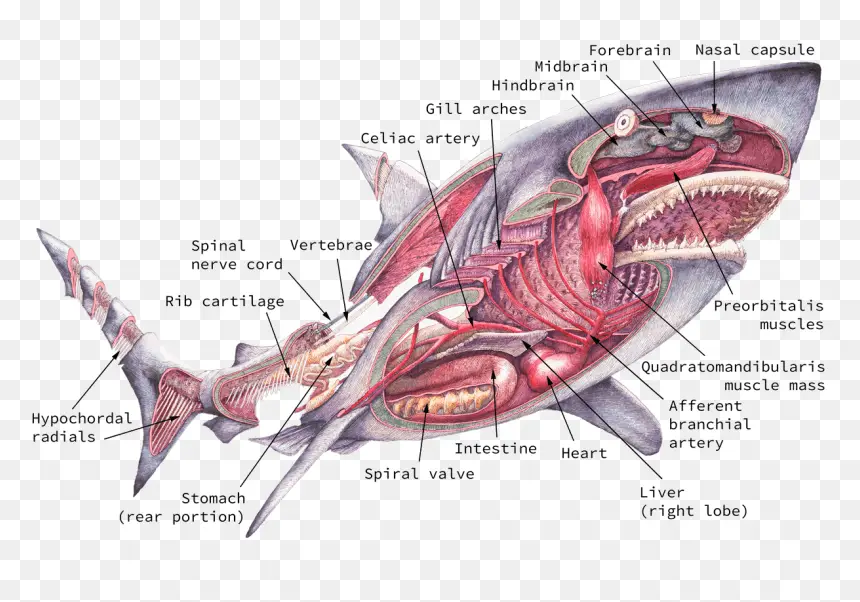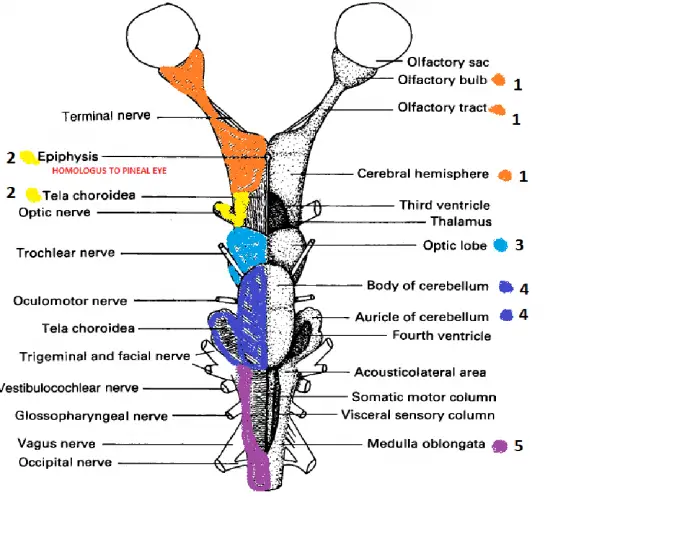The brain and spinal cord form the central nervous system of Scoliodon, the nervous system of different parts of the brain, and the spinal cord together form the complete Central nervous system of Scoliodon.
Table of Contents
The brain of Scoliodon:
The brain is differentiated into three parts- forebrain, midbrain, and hindbrain, the brain is protected inside the chondrocranium.

Forebrain:
Like other advanced Vertebrates, the forebrain of Scoliodon has two parts – the cerebrum and diencephalon.
Cerebrum:
The cerebrum is not divided into two cerebral hemispheres, the mid-dorsal grove present in the higher Vertebrate which divides the cerebrum into two cerebral hemispheres is absent in Scoliodon. From both anterio-lateral sides of the large-sized cerebral hemisphere have two stout stalk-like olfactory stalks or peduncle, each olfactory lobe has its large bilobed olfactory lobe.
On each lateral side, the olfactory lobes are attached to the olfactory sac of each side, each olfactory sac opens outside through the nostril. On the ventral side of the cerebrum, a small opening is present which is known as a neuropore. From the neuropore two-terminal nerve arise, the ganglionated terminal nerves give nerve supply to the mucous membrane of the olfactory sac.
Diencephalon:
Below the cerebrum, on the posterior side, a narrow short diencephalon is present which is not visible due to the cerebellum. The anterior roof of the diencephalon from the vascular anterior choroid plexus, the mid-dorsal wall of the diencephalon has a pineal stalk with a rounded pineal body or epiphysis.
On the ventral side of the diencephalon, two optic nerves form ‘X’ shaped optic chiasma, behind the optic chiasma a hollow projection is present in the backward direction known as infundibulum. On two lateral sides of the infundibulum, two sac-like structures present known as inferior lobe, one posterior region end of the infundibulum a sac, saccus vasculosus together form the pituitary body.

Mid Brain:
Midbrain is not visible from both dorsal and ventral side, on the dorsal side the cerebellum cover the midbrain, on the ventral side infundibular structure covers the midbrain. In the midbrain, the dorsal side has two large dorsal optic lobes. The optic lobes are also known as corpora bigemina, the optic lobe help in vision and hearing, III and IV cranial nerve arise from the midbrain.
Hindbrain:
The hindbrain has two parts, the large rhomboidal cerebellum, and the triangular medulla oblongata.
Cerebellum:
The large-sized cerebellum present dorsally covering the complete midbrain and diencephalon, the dorsal surface of the cerebellum is very irregular. Three transverse furrows divide the cerebellum into three parts, one longitudinal furrow divides the cerebellum into two parts – right half and left half.
Medulla Oblongata:
It is the posterior end of the brain, on the anterior part, it is much broader and triangular but on the posterior side, it tapers gradually adding lead into the spinal cord in the posterior end. On the anterior end, the medulla oblongata has two hollow outgrowths on both sides are known as the restiform body. A transverse band of nerve fibers connects the restiform bodies of two sides of each other.
The posterior choroid plexus makes the roof of the medulla oblongata, cranial nerve V, VI, VII, VIII, IX, and X come out from the midbrain, the midbrain controls the swimming activity in Scoliodon.
Different Brain Cavity:
Inside the brain, we can see some cavities which are interconnected and finally join with the neural canal, the cavities present inside the brain are known as brain ventricles. The ventricles are filled with a special fluid, cerebrospinal fluid, we list the ventricle below.
- Rhinocoel: The brain ventricles present inside the olfactory lobe are known as rhinocoel, the olfactory lobe are responsible for smell.
- Paracoel: In the cerebrum of Scoliodon we can not see two separate cerebral hemispheres but it has two lateral ventricle, Ist ventricle and IInd ventricle.
- Diacoel: The brain ventricle present in diencephalon is known as diacoel or IIIrd ventricle.
- Foramen of Monoro: It is the foramen through which two paracoel of cerebral hemispheres are connected to the IIIrd ventricle or diacoel.
- Iter: Aquiduct of Sylvius or iter is the brain ventricle present in the midbrain which connects the IIIrd ventricle with the IVth ventricle.
- Optocoel: Optocoel is the brain cavity present inside the optic lobe.
- Epicoel: The ventricle present on the dorsal side of brain inside the cerebellum.
- Metacoel: Metacoel or IVth ventricle present inside the medulla part of the hind brain.
Spinal Cord:
The posterior end of the medulla oblongata gradually tapers into the spinal cord which runs up to the tail region. The spinal cord is present inside the lumen of the neural canal of the vertebrae, the spinal cord has a piameter.

The grey matter inside the spinal cord has a dorsal horn and ventral horn, on the outer side the spinal cord has white matter. The spinal cord has a central canal along the axis of the spinal cord, the dorsal horn is united which gives the grey matter an inverted T shape.
Detailed Study On
Respiratory System of Scoliodon
Digestive Glands and Feeding Mechanism in Scoliodon
Coelom and Viscera in Scoliodon
Placoid Scales In Scoliodon (Exoskeleton)
Skin of Scoliodon (Integument)
Hi Everyone!!! Welcome to Imaluop. Imaluop always try to learn some new and he want to share to other people. Here we will try to learn various topics on Science, specially on Biological Sciences.